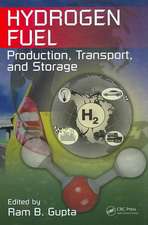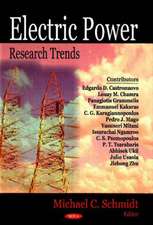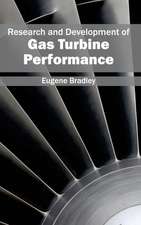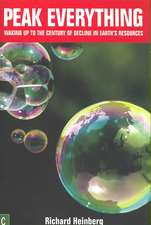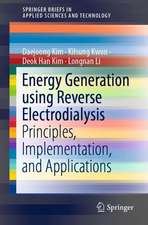Our Renewable Future: Laying the Path for One Hundred Percent Clean Energy
Autor Richard Heinberg, David Fridleyen Limba Engleză Paperback – iun 2016
One of GreenBiz's Six Best Sustainability Books of 2016
The next few decades will see a profound energy transformation throughout the world. By the end of the century (and perhaps sooner), we will shift from fossil fuel dependence to rely primarily on renewable sources like solar, wind, biomass, and geothermal power. Driven by the need to avert catastrophic climate change and by the depletion of easily accessible oil, coal, and natural gas, this transformation will entail a major shift in how we live. What might a 100% renewable future look like? Which technologies will play a crucial role in our energy future? What challenges will we face in this transition? And how can we make sure our new system is just and equitable?
In Our Renewable Future, energy expert Richard Heinberg and scientist David Fridley explore the challenges and opportunities presented by the shift to renewable energy. Beginning with a comprehensive overview of our current energy system, the authors survey issues of energy supply and demand in key sectors of the economy, including electricity generation, transportation, buildings, and manufacturing. In their detailed review of each sector, the authors examine the most crucial challenges we face, from intermittency in fuel sources to energy storage and grid redesign. The book concludes with a discussion of energy and equity and a summary of key lessons and steps forward at the individual, community, and national level.
The transition to clean energy will not be a simple matter of replacing coal with wind power or oil with solar; it will require us to adapt our energy usage as dramatically as we adapt our energy sources. Our Renewable Future is a clear-eyed and urgent guide to this transformation that will be a crucial resource for policymakers and energy activists.
The next few decades will see a profound energy transformation throughout the world. By the end of the century (and perhaps sooner), we will shift from fossil fuel dependence to rely primarily on renewable sources like solar, wind, biomass, and geothermal power. Driven by the need to avert catastrophic climate change and by the depletion of easily accessible oil, coal, and natural gas, this transformation will entail a major shift in how we live. What might a 100% renewable future look like? Which technologies will play a crucial role in our energy future? What challenges will we face in this transition? And how can we make sure our new system is just and equitable?
In Our Renewable Future, energy expert Richard Heinberg and scientist David Fridley explore the challenges and opportunities presented by the shift to renewable energy. Beginning with a comprehensive overview of our current energy system, the authors survey issues of energy supply and demand in key sectors of the economy, including electricity generation, transportation, buildings, and manufacturing. In their detailed review of each sector, the authors examine the most crucial challenges we face, from intermittency in fuel sources to energy storage and grid redesign. The book concludes with a discussion of energy and equity and a summary of key lessons and steps forward at the individual, community, and national level.
The transition to clean energy will not be a simple matter of replacing coal with wind power or oil with solar; it will require us to adapt our energy usage as dramatically as we adapt our energy sources. Our Renewable Future is a clear-eyed and urgent guide to this transformation that will be a crucial resource for policymakers and energy activists.
Preț: 171.83 lei
Nou
Puncte Express: 258
Preț estimativ în valută:
32.88€ • 35.71$ • 27.62£
32.88€ • 35.71$ • 27.62£
Carte disponibilă
Livrare economică 01-15 aprilie
Livrare express 15-21 martie pentru 23.10 lei
Preluare comenzi: 021 569.72.76
Specificații
ISBN-13: 9781610917797
ISBN-10: 1610917790
Pagini: 248
Ilustrații: 14 photos, 33 illustrations
Dimensiuni: 152 x 229 x 15 mm
Greutate: 0.32 kg
Ediția:None
Editura: Island Press
Colecția Island Press
ISBN-10: 1610917790
Pagini: 248
Ilustrații: 14 photos, 33 illustrations
Dimensiuni: 152 x 229 x 15 mm
Greutate: 0.32 kg
Ediția:None
Editura: Island Press
Colecția Island Press
Notă biografică
Richard Heinberg is a Senior Fellow of the Post Carbon Institute and is widely regarded as one of the world’s foremost educators about the need to transition away from fossil fuels. He has authored twelve books, including The Party’s Over: Oil, War, and the Fate of Industrial Societies and Afterburn: Society Beyond Fossil Fuels, and scores of essays and articles that have appeared in such journals as Nature, The American Prospect, The Pacific Standard, Public Policy Research, Quarterly Review, The Ecologist, Resurgence, The Futurist, European Business Review, Earth Island Journal, Yes!, and The Sun.
David Fridley has been a staff scientist at the Energy Analysis Program at the Lawrence Berkeley National Laboratory in California since 1995. He is also Deputy Group Leader of Lawrence Berkeley’s China Energy Group, which collaborates with China on end-user energy efficiency, government energy management programs, and energy policy research. Fridley has written and spoken extensively on the energy and ecological limits of biofuels and serves as Renewable Energy & Energy Efficiency Fellow at Post Carbon Institute.
David Fridley has been a staff scientist at the Energy Analysis Program at the Lawrence Berkeley National Laboratory in California since 1995. He is also Deputy Group Leader of Lawrence Berkeley’s China Energy Group, which collaborates with China on end-user energy efficiency, government energy management programs, and energy policy research. Fridley has written and spoken extensively on the energy and ecological limits of biofuels and serves as Renewable Energy & Energy Efficiency Fellow at Post Carbon Institute.
Cuprins
Acknowledgements
List of Figures and Tables
Introduction
-How “normal” came to be
-Why a renewable world will be different
-Overview of this book
PART I. The Context: It’s All About Energy
Chapter 1. Energy 101
-What is energy? The basics of the basics.
-Laws of Thermodynamics
-Net energy
-Lifecycle impacts
-Operational versus embodied energy
-Energy resource criteria
Chapter 2. A Quick Look At Our Current Energy System
-Growth
-Energy rich, energy poor
-Energy resources
-End use
PART II. Energy Supply in a Renewable World: Opportunities and Challenges
Chapter 3. Renewable Electricity: Falling Costs, Variability, and Scaling Challenges
-Price is less of a barrier
-Intermittency
-Storage
-Grid redesign
-Demand management
-Capacity redundancy
-Scaling challenges
-Lessons from Spain and Germany
-Pushback against wind and solar
Chapter 4. Transportation: The Substitution Challenge
-Electrification
-Biofuels
-Hydrogen
-Natural gas
-Sails and kites
-Summary: A less mobile all-renewable future
Chapter 5. Other Uses of Fossil Fuels: the Substitution Challenge Continues
-High temperature heat for industrial processes
-Low-temperature heat
-Fossil fuels for plastics, chemicals, and other materials
-Summary: Where’s our stuff?
Chapter 6. Energy Supply: How Much Will We Have? How Much Will We Need?
-EROEI of renewables
-Building solar and wind with solar and wind
-Investment requirements
-The efficiency opportunity: We may not need as much energy
-Energy Intensity
-The role of curtailment and the problem of economic growth
Chapter 7. What About…?
-Nuclear power
-Carbon capture and storage
-Massive technology improvements
PART III. Preparing For Our Renewable Future
Chapter 8. Energy and Justice
-Energy and equity in the least industrialized countries
-Energy and equity in rapidly industrializing nations
-Energy and equity in highly industrialized countries
-Policy frameworks for enhancing justice while cutting carbon
Chapter 9. What Government Can Do
-Support for an overall switch from fossil fuels to renewable energy
-Support for research and development of ways to use renewables to power more industrial processes and transport
-Conservation of fossil fuels for essential purposes
-Support for energy conservation in general—efficiency and curtailment
-Better greenhouse gas accounting
Chapter 10. What We the People Can Do
-Individuals and households
-Communities
-Climate and environmental groups, and their funders
Chapter 11. What We Learned
-We really need a plan; no, lots of them
-Scale is the biggest challenge
-It’s not all about solar and wind
-We must begin pre-adapting to having less energy
-Consumerism is a problem, not a solution
-Population growth makes everything harder
-Fossil fuels are too valuable to allocate solely by the market
-Everything is connected
-This really does change everything
About the Authors
List of Figures and Tables
Introduction
-How “normal” came to be
-Why a renewable world will be different
-Overview of this book
PART I. The Context: It’s All About Energy
Chapter 1. Energy 101
-What is energy? The basics of the basics.
-Laws of Thermodynamics
-Net energy
-Lifecycle impacts
-Operational versus embodied energy
-Energy resource criteria
Chapter 2. A Quick Look At Our Current Energy System
-Growth
-Energy rich, energy poor
-Energy resources
-End use
PART II. Energy Supply in a Renewable World: Opportunities and Challenges
Chapter 3. Renewable Electricity: Falling Costs, Variability, and Scaling Challenges
-Price is less of a barrier
-Intermittency
-Storage
-Grid redesign
-Demand management
-Capacity redundancy
-Scaling challenges
-Lessons from Spain and Germany
-Pushback against wind and solar
Chapter 4. Transportation: The Substitution Challenge
-Electrification
-Biofuels
-Hydrogen
-Natural gas
-Sails and kites
-Summary: A less mobile all-renewable future
Chapter 5. Other Uses of Fossil Fuels: the Substitution Challenge Continues
-High temperature heat for industrial processes
-Low-temperature heat
-Fossil fuels for plastics, chemicals, and other materials
-Summary: Where’s our stuff?
Chapter 6. Energy Supply: How Much Will We Have? How Much Will We Need?
-EROEI of renewables
-Building solar and wind with solar and wind
-Investment requirements
-The efficiency opportunity: We may not need as much energy
-Energy Intensity
-The role of curtailment and the problem of economic growth
Chapter 7. What About…?
-Nuclear power
-Carbon capture and storage
-Massive technology improvements
PART III. Preparing For Our Renewable Future
Chapter 8. Energy and Justice
-Energy and equity in the least industrialized countries
-Energy and equity in rapidly industrializing nations
-Energy and equity in highly industrialized countries
-Policy frameworks for enhancing justice while cutting carbon
Chapter 9. What Government Can Do
-Support for an overall switch from fossil fuels to renewable energy
-Support for research and development of ways to use renewables to power more industrial processes and transport
-Conservation of fossil fuels for essential purposes
-Support for energy conservation in general—efficiency and curtailment
-Better greenhouse gas accounting
Chapter 10. What We the People Can Do
-Individuals and households
-Communities
-Climate and environmental groups, and their funders
Chapter 11. What We Learned
-We really need a plan; no, lots of them
-Scale is the biggest challenge
-It’s not all about solar and wind
-We must begin pre-adapting to having less energy
-Consumerism is a problem, not a solution
-Population growth makes everything harder
-Fossil fuels are too valuable to allocate solely by the market
-Everything is connected
-This really does change everything
About the Authors
Recenzii
"Without a doubt the most sensible book...on the prospects and promise of renewable energy."
"The future of renewable energy is obscured by ignorance, noise, ideology, and all sorts of misconceptions —from both cornucopians and catastrophists. Our Renewable Future describes the reality: the transition is possible, but it won’t be easy."
Descriere
One of GreenBiz's Six Best Sustainability Books of 2016
The next few decades will see a profound energy transformation throughout the world, as we shift from fossil fuels to rely primarily on renewable sources like solar, wind, biomass, and geothermal power. What might a 100% renewable future look like, and what challenges might we face in the transition? In Our Renewable Future, energy expert Richard Heinberg and scientist David Fridley explore the challenges and opportunities presented by the shift to renewable energy. Beginning with a comprehensive overview of our current system, the authors survey issues of energy supply and demand in key components of society, including electricity generation, transportation, buildings, and manufacturing. The book concludes with a discussion of energy and equity and a summary of key lessons and steps forward at the individual, community, and national level. Our Renewable Future is a clear-eyed and urgent guide to the renewable energy transformation that will be a crucial resource for policymakers and energy activists.
The next few decades will see a profound energy transformation throughout the world, as we shift from fossil fuels to rely primarily on renewable sources like solar, wind, biomass, and geothermal power. What might a 100% renewable future look like, and what challenges might we face in the transition? In Our Renewable Future, energy expert Richard Heinberg and scientist David Fridley explore the challenges and opportunities presented by the shift to renewable energy. Beginning with a comprehensive overview of our current system, the authors survey issues of energy supply and demand in key components of society, including electricity generation, transportation, buildings, and manufacturing. The book concludes with a discussion of energy and equity and a summary of key lessons and steps forward at the individual, community, and national level. Our Renewable Future is a clear-eyed and urgent guide to the renewable energy transformation that will be a crucial resource for policymakers and energy activists.


